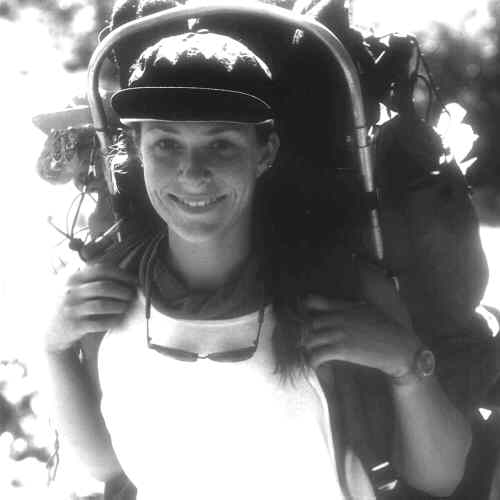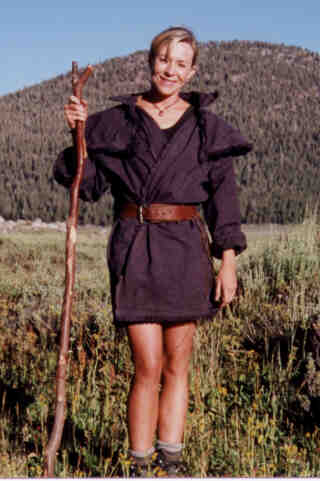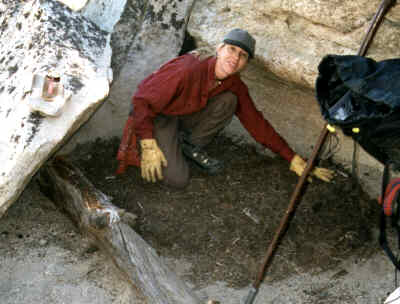Introducing Your Lady to the Woods
By Karen Hood
Photos by Ron Hood
Dayhike – Overnight Hike – Multi-night Outing – Survival Style

(Karen is being featured in her first volume of the new series Woodsmaster Home – Cave Cooking now available)
It’s the first day of one of our private summer wilderness trips. We’re taking a group of seven up for a High Sierra adventure they’ll never forget. A 9-day survival excursion filled with hiking, trapping, skinning, bug eating and much more. I see some of the men looking at me out of the corner of their eyes. I know what they’re thinking. "She can’t be an instructor… she’s married to Ron. I’ll bet Ron takes care of her on these trips. Jeez, now I’m not going to be able to belch out loud. I didn’t think women were into this – "survival," I mean. I’ll bet she’s not strong enough to do this anyway."
We head up the mountain. I tell one of the men his pack doesn’t look like it’s adjusted correctly. And he replies, "I’ve done this before. My pack fits fine." Sure enough, half way up the mountain, he’s already developing compression blisters on his shoulders. During a break, as he sits down, he gives me a sheepish look. I smile gently and say, "Would you like me to check your pack?" He says, "Uh, Would you mind?" One of the lady campers looks at me with a knowing smile. I have the funny feeling he’ll listen to me next time I have a suggestion.
It doesn’t take the group long to learn that Ron and I share camp responsibilities equally. We work as a team to get things done quickly. It just depends on who has the time to do whatever needs to be done. At the first night’s fire, folks are settling in to enjoy the warmth. I could tell that the group is still a little bit formal. Since I feel the urge, I rip out a huge belch… silence. I can almost hear their thoughts. "Did she just belch? I wish I could belch like that." It takes the group a few minutes to process what just happened. Ron fires off a couple of his own and slowly one by one the group members join the chorus. High elevation has this effect on people sometimes.
Let’s talk about the word "Survival." The word carries sort of a Rambo-ish connotation. Sometimes I wonder if it is this connotation that has anything to do with female attitudes towards wilderness skills learning. We’ve found that only about 25% of our customers are female. When I talk to some women, they say it’s the word "survival" that initially frightened them. Not many women would respond very positively to, "Kathy, on our vacation let’s go Survive in the woods together for a week." This brings up a vision of her man dressed in a full-on commando outfit with green and black paint smeared all over his face, a huge sawback fixed-blade knife in one hand and legs poised for action. She thinks about the vision for a moment and says quietly, "No I don’t think so. Can’t we go to the Marriott?"
It is this vision which explains why I prefer to use the phrase Wilderness Skills Training rather than Survival Training. It sounds safer. Somehow commandos don’t invade my vision when I think of "Wilderness Skills training."
What we need to focus on is the concept that we’re here today because both genders have been able to survive equally and together. Survival training is not a "man" thing. Many women enjoy it too. I’d like to see more women enjoying it. I know from experience there’s a lot of men who feel the same way I do or I wouldn’t be writing this article. We’ve learned that survival has very little to do with gender or strength. It has everything to do with knowledge, experience, confidence and practice, practice, practice. Mastering survival techniques and learning new concepts can be an enjoyable life-long pursuit. You can never know too much, but you can know too little.
There’s one thing that I’ve noticed in almost every group we’ve led into the mountains – at least one student who says that he’d love to share this experience with his special lady. He’ll tell me quietly that he was so disappointed when his lady said she’d rather not come along. I always tell them to be patient, supportive, and get her up here so we can feed her a can of beans and teach her our worldly ways. This usually puts a smile on his face as he envisions his dainty little lady trying to hold in what must feel like the explosive compression from a diesel engine.
At this point I’d like to offer some concrete steps to get her involved. This has all been scientifically studied… Uh ha… even our own instructor’s wives have been our guinea pigs. We know it works. For ease of application, I’ve broken these tips into categories. And ladies, feel free to let your man read this if you think he needs some help. 
Dayhike:
If she’s never been out in the wilderness before, this should help get her there:

Before the first outing: Don’t intimidate her with stories of your prowess… ever. Don’t tell her about how you went off hunting for 6 hours to fetch dinner. What she’ll think about is being left alone for that amount of time. DO talk about how beautiful the mountains are going to be and how fresh the air is going to smell. Take time to let her know what you two will be doing together on the trip. Let her know what she can expect with regards to activities you’ll be doing so she can get excited about the day you’ll be spending together. Give her a mini survival kit to carry with her. Our Woodsmaster Volume 3 – Survival Kits shows a great, small kit that would be perfect for this. Have her watch the tape and make the kit. Tell her that one of the many things you’ll be doing when you go on your outing is to practice with the items in the survival kit. This will make her excited that she’ll be learning something new and give her a good idea of what activities you’ll be participating in. Let her know the proper clothes to wear what shoes to wear, etc. The more open with her you are about what to expect the better.
- If it’s her very first time out in the wilderness, keep the first outing to only a day hike on trails with not too much uphill and good weather conditions. You don’t want to take her on a hike up "Incubus Mountain" and expect her to enjoy herself and want to come back for more. The next time you go out, she might even be up for an overnighter. If not, do another day hike.
- When hiking, rest frequently. Don’t "compete" with her to show her you’re in better shape and more capable. Don’t tell her to stop whining because she’s tired or her feet hurt. Do let her know she’s doing a great job and that she can stop to rest whenever she feels like it and vice-versa. If you come to a resting spot, take advantage of it by showing her some places that would be good shelter sites and why. Also show her not-so-good places to set up shelter and why. If you need help with this, we have Woodsmaster Volume 2 – Survival Shelters to help teach you how to distinguish between a bad and good shelter site.
- Be sure you both have on appropriate clothes and a hat, comfortable shoes and carry plenty of water. You don’t want her first hike to become a blistering, puss infected, dehydrated stupor that stays with her for days after you’ve finished the hike. If this happens, she’ll never go out again. "Gee I wonder why she didn’t have a great time.? Maybe it’s that pustule on her foot." (Woodsmaster Volume 4 – Navigation and Wilderness Travel)
- When you’re out together, emphasize the beauty of nature, not just the hazards. Let her know that Yucca plant over there is a wonderful resource as soap or to make cordage. Don’t warn her that there’s going to be rattlesnakes or poisonous leaves everywhere she steps. She might think that everything might be poisonous and be scared to touch any plant she sees. It would help if you knew which plants were poisonous and where poisonous snakes are likely to hang out.

Overnight Hike:
Great, she’s agreed to stay overnight. These tips should help you.
- On your first overnight hike together, show her she’s an important part of the trip by having her carry her own gear. Don’t travel too far. 2-3 miles away from the car is plenty. She can enjoy the outdoors but still feel that if something were to go wrong, she could still get to safety. To add even more fun to the trip, do this in the company of another couple that you’re both friends with.
- Leave the cars early enough in the day so that you will still have sunlight and warmth to set up the camp properly and not feel rushed. Leaving early enough will also assure you that you won’t have a rushed hike in. Take your time and enjoy the trek.
- Teach her camp skills so you can share duties. Don’t make her dependent on you for everything. If you do everything around camp yourself, it will make her feel ignorant and vulnerable. And I don’t mean giving her the duty of just washing the pans. Give her important things to do. For example, show her the proper way to start the camp fire with a sparking tool (Woodsmaster Volume 1 – Spark-Based Firemaking) When she succeeds, she’ll really feel good about herself and might even want to make that duty her very own special contribution to your outings. This will really make her feel like she’s an important part of the whole camping experience… as she is.
Multi-night Outing:
Now that she’s agreed to go out for a few nights you’ve probably done a good job so far. Keep it up.
- She’s getting tougher now. She knows that she’s not going to be a stone’s throw from the car. Safety is a little farther away and there’s more perceived risk. Now you can let her help you plan the trip. And if she says she’s nervous, keep up the praise and remind her how well she did before.
- You might discuss taking a few minutes to be alone (away from each other) while you’re in the mountains. This could give you an opportunity to enjoy the serenity of the wilderness with out idle chatter. Remind her that you won’t be far away and that you’ll be close enough that if she blows her whistle once, you’ll hear her. It’s good to set up a signal, such as a whistle pattern so that you’ll be able to locate each other.
- When the trip is over, make sure you talk about your experiences together. Find out what sort of things she liked or disliked about the whole thing. You can talk to her about what you liked and disliked as well. If she says that she likes a certain activity, say fishing, you will know that the next time you go out together, fishing will be on top of the list of things for her to do. The same goes for you. If there is something that you didn’t particularly like to do, next time you can plan to not include it in your activities.
- After the trip when you’re cleaned, refreshed and well-rested, talk about how great the trip was and how you wish you were up there now. She’ll probably agree with you, particularly if it was a nice trip.
Survival Style:
If you’ve made it this far, you’ll have your hands full. You’d better get out your good hiking shoes ’cause you’re going to need them. You’ve now got a new trail buddy. And if you need that survival training, practice the skills in the Woodsmaster video series.
We’ve heard from many customers, including couples and families with children, that they feel much more secure on their outings after viewing the Woodsmaster videos together. Because they’re entertaining, it’s easier to remember the techniques taught.
If you do want to get started at home, these videos are informative, humorous, and most of all affordable. Visit us at www.survival.com. To order, call Toll Free (888) 257-BUGS. Mention this article and ask about our monthly specials.
If you already have our Woodsmaster Videos which feature Ron Hood, consider purchasing Karen’s first volume of Woodsmaster Home – Cave cooking. Karen shows you how to harvest naturally occurring yeast for bread making, how to cook muffins in the incredible Wilderness stone oven. Learn to collect and prepare grubs and wild berries for food, make delicious marmot stew, how to clean and cook fish as well as a bunch of other Woodsmaster tips and techniques.












